
ON THIS PAGE
- How to Start a Catering Business
- 15 Steps To Start a Catering Business
- How Big is the Catering Industry?
- What are the Key Segments of the Catering Industry?
- What External Factors Affect the Catering Industry?
- What are the Key Customer Segments in the Catering Industry?
- What are the Key Costs in the Catering Industry?
- What are the Typical Startup Costs for a new Catering Business?
- Sustainable Catering for a Better Tomorrow
- Helpful Videos
- Additional resources in the catering industry
How to Start a Catering Business
If you’re looking to start a catering business, you’ve come to the right place since we’re going to show you exactly how to do it.
We’ll start with key catering industry fundamentals like how big the market is, what the key segments are, and how revenues and profits are generated.
Then we’ll discuss keys to not only starting a catering business but succeeding in it!
And don’t forget to look at our catering business plan template if you need a plan to start or grow your catering company.
15 Steps To Start a Catering Business:
Starting a catering business can be very profitable. With proper planning, execution and hard work, you can enjoy great success. Below you will learn the keys to launching a successful catering business.
1. Choose the Name for Your Catering Business
The first step to starting a catering business is to choose your business’ name.
This is a very important choice since your company name is your brand and will last for the lifetime of your business. Ideally you choose a name that is meaningful and memorable. Here are some tips for choosing a name for your catering business:
- Make sure the name is available. Check your desired name against trademark databases and your state’s list of registered business names to see if it’s available. Also check to see if a suitable domain name is available.
- Keep it simple. The best names are usually ones that are easy to remember, pronounce, and spell.
- Think about marketing. Come up with a name that reflects the desired brand and/or focus of your catering business.
2. Determine the Type of Catering Business You Will Launch
When deciding to launch a catering business, it’s important to determine the specific type or niche of catering services you will offer. Your choice will influence your target market, menu offerings, and marketing strategy.
Here are several types of catering businesses you can consider:
- Wedding Catering: Specialize in providing catering services for weddings and related events, offering elegant and customized menus that suit the bride and groom’s preferences.
- Corporate Catering: Focus on catering for corporate events, such as meetings, conferences, seminars, and office parties. Emphasize convenience, professionalism, and a diverse menu.
- Event Catering: Offer catering services for a wide range of events, including birthdays, anniversaries, holiday parties, and family gatherings. Create menus that cater to different occasions and themes.
- Specialty Cuisine Catering: Concentrate on a specific type of cuisine, such as Italian, Mexican, Asian, or Mediterranean, and offer authentic dishes for events and gatherings.
- Health-Conscious Catering: Develop a catering business that focuses on providing healthy and nutritious meal options, accommodating dietary restrictions and preferences.
3. Develop Your Catering Business Plan
One of the most important steps in starting a catering business is to develop your business plan. The process of creating your plan ensures that you fully understand your market and your business strategy. The plan also provides you with a roadmap to follow and if needed, to present to funding sources to raise capital for your business.
To enhance your planning process, incorporating insights from a sample catering business plan can be beneficial. This can provide you with a clearer perspective on industry standards and effective strategies, helping to solidify your own business approach.
Your business plan should include the following sections:
- Executive Summary: This section should summarize your entire business plan so readers can quickly understand the key details of your catering business.
- Company Overview: This section tells the reader about the history of your catering business and what type of catering business you operate. For example, are you a wedding catering, corporate catering, or event catering business.
- Industry Analysis: Here you will document key information about the catering industry. Conduct market research and document how big the industry is and what trends are affecting it.
- Customer Analysis: In this section, you will document who your ideal or target customers are and their demographics. For example, how old are they? Where do they live? What do they find important when purchasing products like the ones you will offer?
- Competitive Analysis: Here you will document the key direct and indirect competitors you will face and how you will build a competitive advantage.
- Marketing Plan – your marketing plan should address the 4Ps: Product, Price, Promotions and Place.
- Product: Determine and document what products/services you will offer
- Prices: Document the prices of your products/services
- Place: Where will your business be located and how will that location help you increase sales?
- Promotions: What promotional methods will you use to attract customers to your catering business? For example, you might decide to use pay-per-click advertising, public relations, search engine optimization, and/or social media marketing.
- Operations Plan – here you will determine the key processes you will need to run your day-to-day operations. You will also determine your staffing needs. Finally, in this section of your plan, you will create a projected growth timeline showing the milestones you hope to achieve in the coming years.
- Management Team – this section details the background of your company’s management team.
- Financial Plan – finally, the financial plan answers questions including the following:
- What startup costs will you incur?
- How will your catering business make money?
- What are your projected sales and expenses for the next five years?
- Do you need to raise funding to launch your business?
You can download our catering business plan PDF template here. This is a business plan template you can use in PDF format.
Finish Your Business Plan Today!
If you’d like to quickly and easily complete your business plan, download Growthink’s Ultimate Business Plan Template and complete your plan and financial model in hours.
4. Choose the Legal Structure for Your Catering Business
Next you need to choose a legal structure for your catering business and register it and your business name with the Secretary of State in each state where you operate your business.
Below are the five most common legal structures:
1) Sole Proprietorship
A sole proprietorship is a business entity in which the owner of the catering business and the business are the same legal person. The owner of a sole proprietorship is responsible for all debts and obligations of the business. There are no formalities required to establish a sole proprietorship, and it is easy to set up and operate. The main advantage of a sole proprietorship is that it is simple and inexpensive to establish. The main disadvantage is that the owner is liable for all debts and obligations of the business.
2) Partnerships
A partnership is a legal structure that is popular among small businesses. It is an agreement between two or more people who want to start a catering business together. The partners share in the profits and losses of the business.
The advantages of a partnership are that it is easy to set up, and the partners share in the profits and losses of the business. The disadvantages of a partnership are that the partners are jointly liable for the debts of the business, and disagreements between partners can be difficult to resolve.
3) Limited Liability Company (LLC)
A limited liability company, or LLC, is a type of business entity that provides limited liability to its owners. This means that the owners of an LLC are not personally responsible for the debts and liabilities of the business. The advantages of an LLC for a catering business include flexibility in management, pass-through taxation (avoids double taxation as explained below), and limited personal liability. The disadvantages of an LLC include lack of availability in some states and self-employment taxes.
4) C Corporation
A C Corporation is a business entity that is separate from its owners. It has its own tax ID and can have shareholders. The main advantage of a C Corporation for a catering business is that it offers limited liability to its owners. This means that the owners are not personally responsible for the debts and liabilities of the business. The disadvantage is that C Corporations are subject to double taxation. This means that the corporation pays taxes on its profits, and the shareholders also pay taxes on their dividends.
5) S Corporation
An S Corporation is a type of corporation that provides its owners with limited liability protection and allows them to pass their business income through to their personal income tax returns, thus avoiding double taxation. There are several limitations on S Corporations, including the number of shareholders they can have, among others.
Once you register your catering business, your state will send you your official “Articles of Incorporation.” You will need this among other documentation when establishing your banking account (see below). We recommend that you consult an attorney in determining which legal structure is best suited for your company.
Incorporate Your Business at the Guaranteed Lowest Price
We are proud to have partnered with Business Rocket to help you incorporate your business at the lowest price, guaranteed.
Not only does BusinessRocket have a 4.9 out of 5 rating on TrustPilot (with over 1,000 reviews) because of their amazing quality…but they also guarantee the most affordable incorporation packages and the fastest processing time in the industry.
Incorporate with BusinessRocket at the guaranteed lowest price now.
5. Secure Startup Funding for Your Catering Business (If Needed)
In developing your catering business plan, you might have determined that you need to raise funding to launch your business.
If so, the main sources of funding for a catering business to consider are personal savings, family and friends, credit card financing, bank loans, crowdfunding and angel investors. Angel investors are individuals who provide capital to early-stage businesses. Angel investors typically will invest in a catering business that they believe has high potential for growth.
6. Secure a Location for Your Business
Finding the right space for your catering business is crucial for its success.
Here are some factors to consider when selecting a location for your catering business:
- Commercial Kitchen: Look for a location with a well-equipped commercial kitchen that meets health and safety regulations. Ensure it has ample space for food preparation, cooking, and storage.
- Accessibility: Choose a location that is easily accessible to your clients and suppliers. Consider proximity to major roads, highways, and public transportation for convenience.
- Storage Facilities: Adequate storage is essential for ingredients, supplies, and equipment. Ensure the space has storage rooms, refrigeration, and freezer facilities.
- Commissary Kitchen: If you’re starting small or on a budget, consider sharing a commissary kitchen with other food businesses as a cost-effective option.
- Ventilation and Exhaust Systems: Proper ventilation and exhaust systems are vital for maintaining air quality and fire safety in your kitchen.
- Parking: If you plan to meet with clients or host tastings on-site, having ample parking space for clients and delivery vehicles is important.
7. Register Your Catering Business with the IRS
Next, you need to register your business with the Internal Revenue Service (IRS) which will result in the IRS issuing you an Employer Identification Number (EIN).
Most banks will require you to have an EIN in order to open up an account. In addition, in order to hire employees, you will need an EIN since that is how the IRS tracks your payroll tax payments.
Note that if you are a sole proprietor without employees, you generally do not need to get an EIN. Rather, you would use your social security number (instead of your EIN) as your taxpayer identification number.
8. Open a Business Bank Account
It is important to establish a bank account in your catering business’ name. This process is fairly simple and involves the following steps:
- Identify and contact the bank you want to use
- Gather and present the required documents (generally include your company’s Articles of Incorporation, driver’s license or passport, and proof of address)
- Complete the bank’s application form and provide all relevant information
- Meet with a banker to discuss your business needs and establish a relationship with them
9. Get a Business Credit Card
You should get a business credit card for your catering business to help you separate personal and business expenses.
You can either apply for a business credit card through your bank or apply for one through a credit card company.
When you’re applying for a business credit card, you’ll need to provide some information about your business. This includes the name of your business, the address of your business, and the type of business you’re running. You’ll also need to provide some information about yourself, including your name, Social Security number, and date of birth.
Once you’ve been approved for a business credit card, you’ll be able to use it to make purchases for your business. You can also use it to build your credit history which could be very important in securing loans and getting credit lines for your business in the future.
10. Get the Required Business Licenses and Permits
Starting a catering business involves obtaining various licenses and permits to operate legally and ensure compliance with health and safety regulations. The specific licenses and permits you need may vary depending on your location and the scale of your business.
Here are some common licenses and permits required for a catering business:
- Business License: A general business license is typically required to legally operate any business in your city or municipality. Check with your local government for specific requirements and fees.
- Food Service License: Obtain a food service license from your local health department or regulatory agency. This license ensures that you comply with food safety and sanitation standards. You may need to undergo inspections to receive and maintain this license.
- Caterer’s Permit: Some states or local authorities require caterers to have a special catering permit in addition to the standard food service license. This permit may cover off-site catering events.
- Sales Tax Permit: If your state imposes sales tax on prepared food and beverages, you’ll need a sales tax permit to collect and remit these taxes to the state. Check your state’s tax department for details.
- Alcohol License: If you plan to serve alcoholic beverages at your catering events, you’ll need an alcohol license or permit. The type of license required (e.g., beer and wine, full liquor) varies by jurisdiction.
- Health Department Permit: In addition to the food service license, some catering businesses may require specific permits related to food handling, storage, and transportation. These may include food establishment permits, mobile food vendor permits, or temporary food service permits for off-site events.
Depending on the type of catering business you launch, you will have to obtain the necessary state, county and/or city licenses.
11. Get Business Insurance for Your Catering Business
Operating a catering business involves various risks, and having the right insurance coverage is crucial to protect your business, assets, and clients.
Here are some types of insurance you should consider for your catering business:
- General Liability Insurance: This fundamental insurance coverage protects your business from a wide range of common risks, including bodily injury, property damage, and personal injury claims. It can cover legal fees, settlements, and medical expenses if a client or guest is injured at an event or if your catering operations cause damage to a venue.
- Product Liability Insurance: If a client or guest becomes ill due to food poisoning or other food-related illnesses caused by your catering services, product liability insurance can cover the costs of legal claims, medical expenses, and settlements.
- Liquor Liability Insurance: If you serve alcohol at your catering events, liquor liability insurance is essential. It covers legal claims related to injuries, property damage, or accidents caused by intoxicated guests who were served alcohol by your catering staff.
- Commercial Property Insurance: This insurance protects your business property, including kitchen equipment, catering supplies, and storage facilities, against damage or loss due to events like fire, theft, vandalism, or natural disasters.
- Business Interruption Insurance: If a covered event, such as a fire, disrupts your catering operations and forces you to temporarily close, business interruption insurance can provide compensation for lost income and ongoing expenses during the downtime.
- Workers’ Compensation Insurance: If you have employees, workers’ compensation insurance is often mandatory. It covers medical expenses and lost wages for employees who are injured or become ill while on the job.
- Commercial Auto Insurance: If your catering business uses vehicles for deliveries or transportation to events, commercial auto insurance is essential to cover accidents, injuries, and property damage involving company vehicles.
Find an insurance agent, tell them about your business and its needs, and they will recommend policies that fit those needs.
12. Buy or Lease the Right Catering Business Equipment
Running a catering business requires a variety of equipment to prepare, transport, and serve food at events and venues. The specific equipment you need can depend on the scale and scope of your catering operations.
Here is a list of essential equipment commonly used in a catering business:
- Commercial Range and Ovens: Used for cooking and baking a wide range of dishes.
- Grills: Essential for grilling meats, vegetables, and seafood.
- Refrigeration Units: Walk-in coolers, reach-in refrigerators, and freezers for storing perishable ingredients and prepared dishes.
- Food Prep Tables: Stainless steel worktables for food preparation and assembly.
- Mixers and Blenders: Used for mixing and blending ingredients for sauces, dressings, and beverages.
- Food Processors: Useful for chopping, slicing, dicing, and pureeing ingredients.
- Steamers: Ideal for cooking vegetables, seafood, and rice.
- Commercial Dishwashers: For efficient cleaning and sanitizing of dishes, utensils, and cookware.
- Sinks: Multiple sinks for food preparation, handwashing, and dishwashing.
- Cookware and Bakeware: Pots, pans, baking sheets, and utensils for cooking and baking.
13. Develop Your Catering Business Marketing Materials
Marketing materials will be required to attract and retain customers to your catering business.
The key marketing materials you will need are as follows:
- Logo: Spend some time developing a good logo for your catering business. Your logo will be printed on company stationery, business cards, marketing materials, and so forth. The right logo can increase customer trust and awareness of your brand.
- Website: Likewise, a professional catering business website provides potential customers with information about the products you offer, your company’s history, and contact information. Importantly, remember that the look and feel of your website will affect how customers perceive you.
- Social Media Accounts: Establish social media accounts in your company’s name. Accounts on Facebook, Twitter, LinkedIn, and/or other social media networks will help customers and others find and interact with your catering business.
14. Purchase and Setup the Software Needed to Run Your Catering Business
Most catering businesses need accounting software and customer relationship management (CRM) software.
While there are many different software options available, some of the most popular programs for accounting include QuickBooks and Xero. Some of the most popular CRM programs include Salesforce, and Zoho.
Research the software that best suits your needs, purchase it, and set it up.
15. Open for Business
You are now ready to open your catering business. If you followed the steps above, you should be in a great position to build a successful business. Below are answers to frequently asked questions that might further help you.
Finish Your Business Plan Today!
If you’d like to quickly and easily complete your business plan, download Growthink’s Ultimate Business Plan Template and complete your plan and financial model in hours.
How Big is the Catering Industry?
There are 111,909 catering businesses in the U.S. that generated $11.6 billion in revenue last year. This represents an annual growth rate of 1.8% over the past five years.
What are the Key Segments of the Catering Industry?
The main segments of the catering industry are off-premise events and on-premise events, both of which, account for equal parts of the industry’s total revenue.
Finish Your Business Plan Today!
If you’d like to quickly and easily complete your business plan, download Growthink’s Ultimate Business Plan Template and complete your plan and financial model in hours.
What External Factors Affect the Catering Industry?
A number of factors affect the performance of the catering industry. These drivers include:
- Consumer spending: As consumer spending increase, they also tend to spend more money in catering services.
- Corporate profit: Companies are the top customers of catering businesses. When company’s income increases, their budget for corporate events which includes catering costs also increases. Last year, corporate profit increased.
- External competition for the Catering industry: This comprises of restaurants and hotels that offer function rooms for corporate events, and packed meals available in the market. The increase of external competition threatens the catering industry because they are more time and cost-efficient.
- Demand from trade show and conference planning: Trade shows and conferences highly need catering services. Therefore an increase in events positively affects the catering industry.
- Households earning more than $100,000: A huge percentage of revenue that catering businesses generate come from household incomes, so when households earn more than $100,000, they tend to spend more on food and catering services.
What are the Key Customer Segments in the Catering Industry?
At almost 58%, households are the largest customer segment for the catering industry. Businesses and the government then account for the remaining key consumer segments.
What are the Key Costs in the Catering Industry?
Purchases – Last year, more than 1/3 of the catering business revenue is allocated to purchases.
Wages – Due to the labor intensive nature of the industry, wages account for almost a quarter of costs.
Other – Other costs include rent, utilities, marketing and other misc. costs.
What are the typical startup costs for a new catering business?
The typical start-up costs for a catering business include:
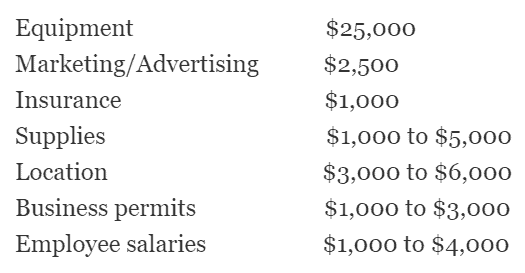
Finish Your Business Plan Today!
If you’d like to quickly and easily complete your business plan, download Growthink’s Ultimate Business Plan Template and complete your plan and financial model in hours.
Sustainable Catering for a Better Tomorrow
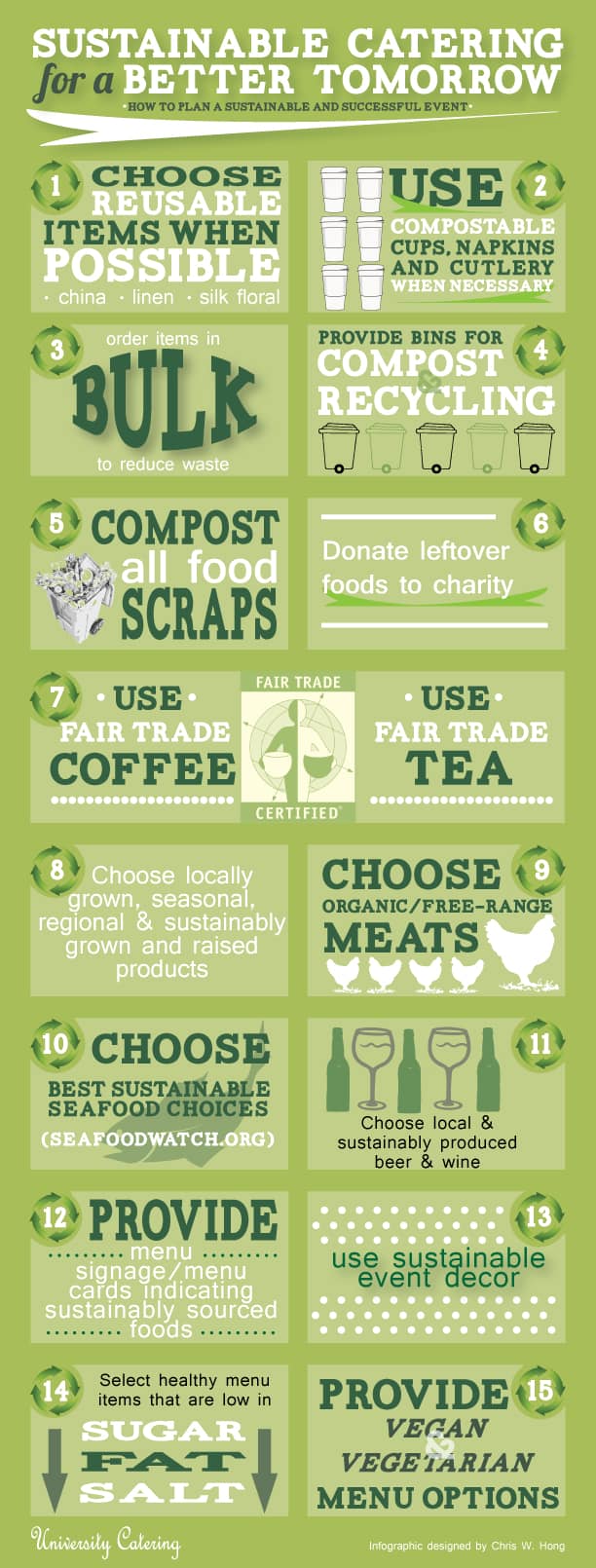
Sample desserts prepared by caterers
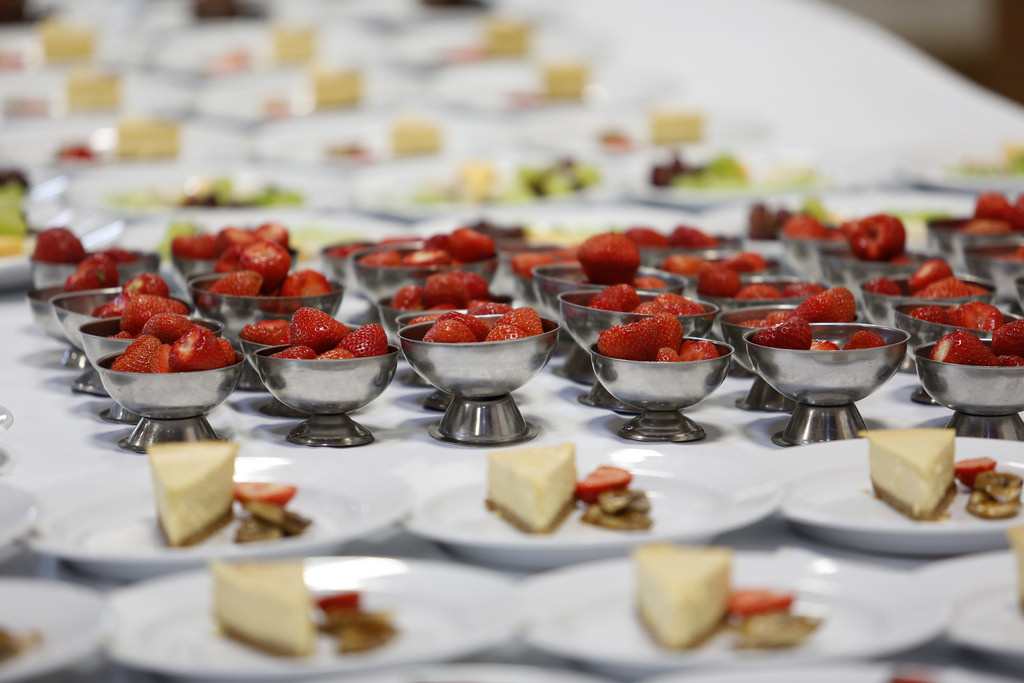

Catering table arrangements
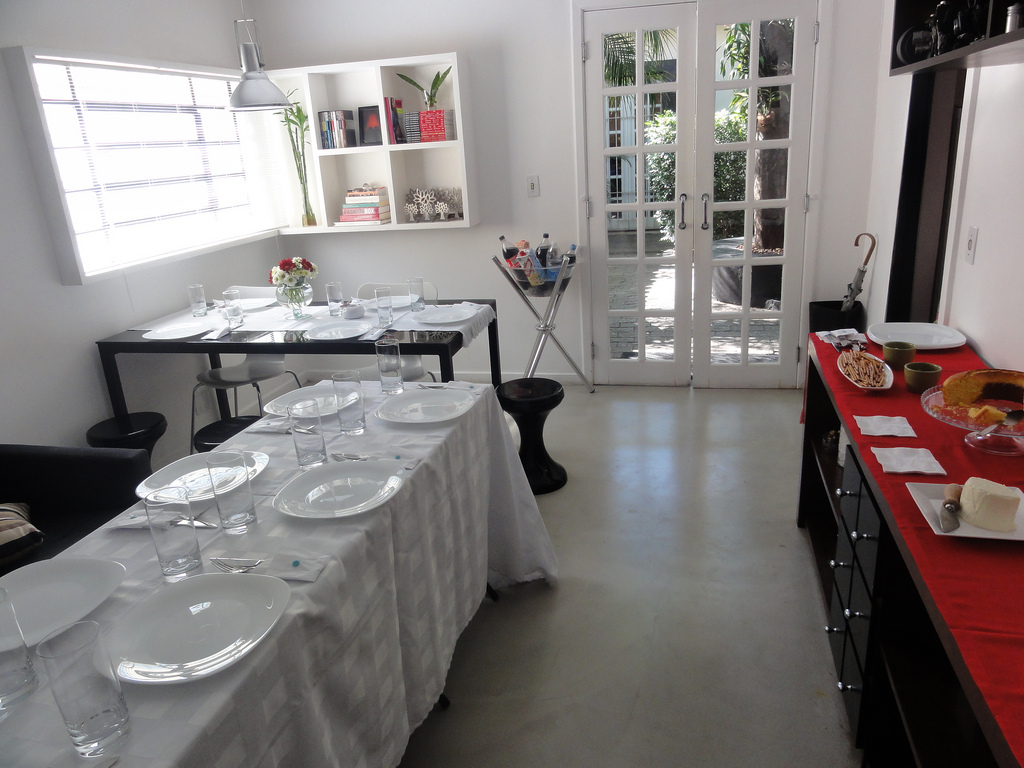
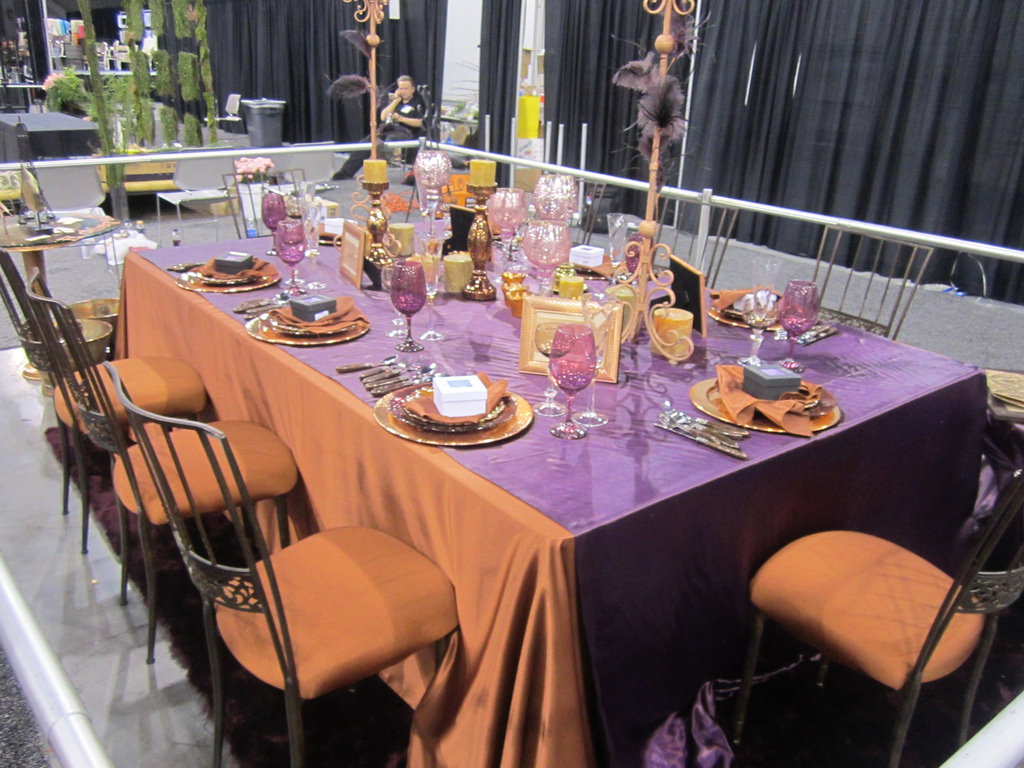
Helpful Videos
Insider Secrets to Grow Your Catering Business
5 Tips for Hosting and Catering a Successful Event
Pricing Your Catering Menu
Additional resources in the catering industry
- Food Management Magazine: www.foodservicedirector.com
- International Caterers Association (ICA): www.internationalcaterers.org
- US Census Bureau: www.census.gov
- Special Events Magazine: www.specialevents.com/catering
- National Association for Catering and Events (NACE): www.nace.net
- Catering Mavericks: www.cateringmavericks.com
Finish Your Catering Business Plan in 1 Day!
Don’t you wish there was a faster, easier way to finish your business plan?
With Growthink’s Ultimate Catering Business Plan Template you can finish your plan in just 8 hours or less!
OR, Let Us Develop Your Plan For You
Since 1999, Growthink’s business plan consulting team has developed business plans for thousands of companies who have gone on to achieve tremendous success.
Click here to see how Growthink’s business plan writing services can help you create a great business plan.

 Business Plan Template & Guide For Small Businesses
Business Plan Template & Guide For Small Businesses Catering Business Plan
Catering Business Plan Food Truck Business Plan
Food Truck Business Plan